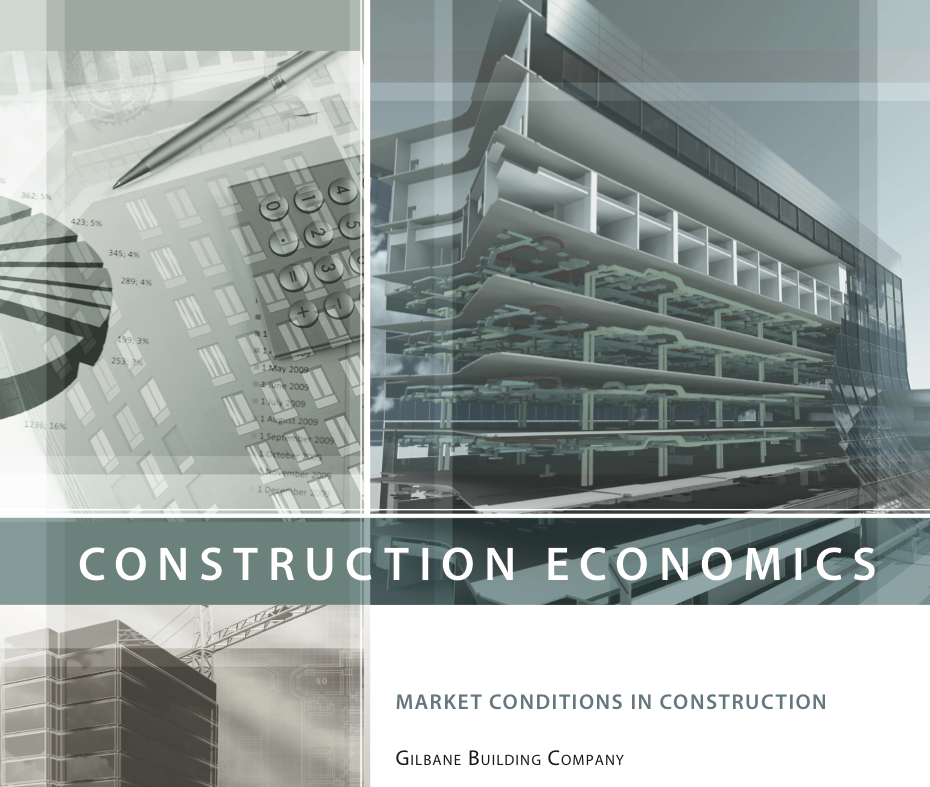The construction sector in the nine states with 50% of construction employment was up 169,000 jobs from February to September 2012, following a lost of 137,000 jobs from September 2011 to January 2012.
That’s one of the key findings of “Construction Economics: Market Conditions in Construction” (November 2012), by Gilbane Building Co., Providence, R.I. The construction management giant found several others reasons to report that construction growth was looking up:
- Construction spending for nonresidential buildings should be up 4.9% in 2012 over 2011, to $297 billion. Residential should be up 12% YOY, putting total building construction ahead 8% for the year.
- Construction starts are increasing at a slow but upward rate, while backlog duration is also increasing. As a result, contractors are feeling somewhat more comfortable passing along material cost increases.
- Overall construction spending for 2013 should be up another 4.9%, with residential building dollars up 11%.
- Top sectors: healthcare and education, accounting for 40% of nonresidential building spending.
The Gilbane report drops the other shoe with several negative findings. For one, publicly funded work will likely be down in 2013 due to the paucity of bond issues passed in the November election period: about $30 billion, compared to more than $60 billion in 2008.
Moreover, spending on public construction has declined 5% YOY and was expected to finish 2012 12% below the 2009 peak. The Gilbane report forecasts a further drop in public construction in 2013, for the fourth consecutive year.
And while there has been some recent hiring, the construction workforce has lost 2.25 million, or 29%, in recent years. “It will be many years before the entire workforce grows back to its previous level,” the Gilbane report says.
More info: info.gilbaneco.com/Portals/160261/docs/economicreportwinter2012.pdf. +
Related Stories
| Nov 11, 2013
4 trends driving the recovering commercial construction sector
Jones Lang LaSalle research reveals a four-point “new look” for the post-recession construction industry.
| Nov 8, 2013
Oversized healthcare: How did we get here and how do we right-size?
Healthcare facilities, especially our nation's hospitals, have steadily become larger over the past couple of decades. The growth has occurred despite stabilization, and in some markets, a decline in inpatient utilization.
| Nov 8, 2013
Can Big Data help building owners slash op-ex budgets?
Real estate services giant Jones Lang LaSalle set out to answer these questions when it partnered with Pacific Controls to develop IntelliCommand, a 24/7 real-time remote monitoring and control service for its commercial real estate owner clients.
| Nov 8, 2013
S+T buildings embrace 'no excuses' approach to green labs
Some science-design experts once believed high levels of sustainability would be possible only for low-intensity labs in temperate zones. But recent projects prove otherwise.
| Nov 8, 2013
Net-zero bellwether demonstrates extreme green, multifamily style
The 10-unit zHome in Issaquah Highlands, Wash., is the nation’s first net-zero multifamily project, as certified this year by the International Living Future Institute.
| Nov 8, 2013
Walkable solar pavement debuts at George Washington University
George Washington University worked with supplier Onyx Solar to design and install 100 sf of walkable solar pavement at its Virginia Science and Technology Campus in Ashburn, Va.
| Nov 6, 2013
PECI tests New Buildings Institute’s plug load energy use metrics at HQ
Earlier this year, PECI used the NBI metrics to assess plug load energy use at PECI headquarters in downtown Portland, Ore. The study, which informed an energy-saving campaign, resulted in an 18 percent kWh reduction of PECI’s plug load.
| Nov 5, 2013
Net-zero movement gaining traction in U.S. schools market
As more net-zero energy schools come online, school officials are asking: Is NZE a more logical approach for school districts than holistic green buildings?
| Nov 5, 2013
New IECC provision tightens historic building exemption
The International Energy Conservation Code has been revised to eliminate what has been seen as a blanket exemption for historic buildings.
| Nov 5, 2013
Living Building Challenge clarifies net-zero definitions and standards
The Living Building Challenge has released the Net Zero Energy Building Certification to provide clearer definitions regarding what net zero really means and how it is to be achieved.

















